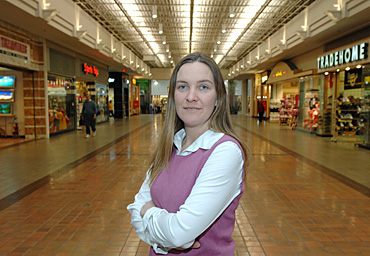State retail sales are down 2.7 percent since 2000 according to new ReCAP report
06-05-08

Meghan O'Brien, an ISU economist who is pictured here at the North Grand Mall in Ames, authored a report that takes a comparative look at Iowa retail sales from 2000-07. Photo by Bob Elbert
Contacts:
Meghan O'Brien, Regional Capacity Analysis Program, (515) 294-4095, mcobrien@iastate.edu
Mike Ferlazzo, News Service, (515) 294-8986, ferlazzo@iastate.edu
State retail sales are down 2.7 percent since 2000 according to new ReCAP report
AMES, Iowa -- The state's retail business is not booming according to the new Retail Sales Analysis & Report by Iowa State University's Regional Capacity Analysis Program (ReCAP). Authored by ISU economist Meghan O'Brien, the report found that taxable retail sales in Iowa have declined by 2.7 percent from 2000-07, while per capita sales have declined by 6 percent.
O'Brien reports that more than 100 communities across the state have experienced sales declines of at least 10 percent over those seven years -- with 59 experiencing more than a 20-percent decline. Many of the communities found on the report's list of largest retail sales declines were from Iowa's shrinking rural communities -- with Buffalo (down 57.92 percent) and Shenandoah (down 52.88 percent) topping that list.
But it wasn't just the small towns that took a hit. Iowa's largest city, Des Moines, ranked 23rd on that list with sales declines of 29.14 percent.
O'Brien says Des Moines' loss has been a product of the suburbs' gains. Two of the city's thriving suburban communities -- Altoona (198.47 percent) and Grimes (158.19 percent) -- are second and fourth respectively on the list of retail sales increases. All of Des Moines' prominent suburban communities were among that list's top 15 -- including Pleasant Hill (seventh, up 91.19 percent), Waukee (ninth, up 74.77 percent), Ankeny (12th, up 65.24 percent) and Urbandale (14th, up 57.88 percent).
"About 20 years ago, it was the major metro areas that saw the growth, now it's the ancillary cities," said O'Brien, an ISU Extension program specialist. "Meanwhile, rural towns are seeing rapid, rapid decline. I think this (report) is a reflection that there isn't a one-to-one relationship between winners and losers when it comes to retail trade. There are many more communities that are losing shoppers and those shoppers are filtering into a shrinking number of trade centers over time."
O'Brien used data obtained in the Iowa Retail Sales and Use Tax Report generated by the Iowa Department of Revenue to compile the report, which is also broken down by individual counties and cities. The Department of Revenue compiles data from quarterly state sales tax returns and reports data from all localities with at least 10 businesses holding sales tax permits.
O'Brien warns that retail sales numbers alone can be a misleading in terms of a community's health, since cities that didn't previously have many businesses can boost their sales dramatically with the addition of a large business or new development. She says the report's pull factor ratio is a better measure. It is derived by dividing the trade area capture estimate by the community's population.
"Pull factors take into account local income levels as well as sales per capita, so they give you the best idea of how your town is performing," she said. "With pull factors, if the number is bigger than one, you're doing well. If it's less than one, you're losing sales to another community."
The report showed a decline in the retail health of small towns and rural communities. O'Brien found that from 1978-2007, 18 of Iowa's 21 peer groups -- a grouping of Iowa's cities based on population, degree or urbanization of their subject county, and adjacency to metropolitan areas -- experienced a decline in the pull factor index. The three that exhibited increases all had populations greater than 10,000 and were found in urban or metropolitan counties.
Since rural communities are losing income because population and corresponding business are being pulled to the larger metropolitan areas, O'Brien says it's time for the leaders of those communities to change the way they do business.
"Rural health has been declining for some time and in terms of retail, it's becoming a bigger issue to those communities all the time," she said. "The biggest thing I took out of this report is it's time for rural communities to start thinking of different ways to conduct their retail business. Since the people (population) aren't in the rural areas, they need to try and start thinking about how they can more aggressively tap into urban markets. It's a way to think about rural health for years to come."
The complete Iowa Community Reports, which includes the retail sales reports, can be found at http://www.recap.iastate.edu/local/. They also include reports on population trends, child well-being and school district profiles.
-30-